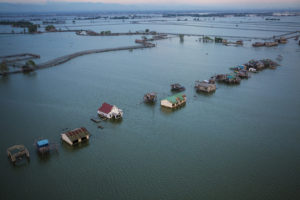Climate change could create two billion more refugees – study
Global sea level rises could create hundreds of millions more refugees by 2100, according to alarming new research.
A study by US sociologist Charles Geisler found that by the year 2100, rising sea levels could force up to two billion people inland, creating a refugee crisis among one-fifth of the world’s population.
And worse still, there may not be many places for these refugees to go because inland landscapes have significant barriers to entry for coastal climate migrants.
 Cornell University-based Dr Geisler’s work appeared in the journal Land Use Policy.
Cornell University-based Dr Geisler’s work appeared in the journal Land Use Policy.
It comes as another study based on satellite data and published in the journal Nature Climate Change shows sea level rises have spiked 50 per cent in just over two decades.
Dr Geisler described the outlook as “a pending crisis”.
“This relocation and huge mass migration from the coastal zone, it’s going to take place in this century and the next century,” he said.
Dr Geisler arrived at the two billion figure by extrapolating from earlier studies.
“We looked for estimates in these various barriers to entry that were coming from the most draconian changes that could hit us from climate change and sea level rise,” he said.
Dr Geisler identified three obstacles, or “barriers to entry,” to relocating people driven inland from their homes by rising seas.
He said that the first problem was that climate change isn’t just affecting coastal communities. Droughts and desertification could make areas safe from sea level rise uninhabitable or incapable of sustaining a large influx of migrants.
Dr Geisler said the second issue was closely linked to the first.
“If climate refugees flock to cities, increasing the urban sprawl into land once used to farm food, those metropolises could lose the ability to feed their inflated populations,” he said.
Dr Geisler said the third issue involved physical and legal barriers, alluding to regional authorities erecting walls and posting guards to prevent climate migrants from entering and settling down.
He dubbed this phenomenon the “no-trespass zone.”
Dr Geisler said that there has been too much focus on building sea walls, learning to live with floods and relocating communities inland.
He said these limited ideas of “adaptation” could leave humanity unprepared for a mass migration that could dwarf the current refugee crisis in Europe.
“My hope is that this paper will reorient planners and policymakers who use the term ‘adaptation’ in a very narrow way,” Dr Geisler said.
“It’s used either to mean fortifying coastal structures to keep the sea off the land, or it’s used to refer to moving a population from a coastal zone in some organized way,” he said
Dr Geisler said there were better ways to prepare for dealing with the possible results of runaway climate change which required “transboundary” planning.
“Climate change is going to be with us for a long time, and the coastal zone population is going to be overwhelming as it moves inland,” he said.
“How are we going to employ these people? Where are we going to house them? What energy sources are they going to need?”
“The bottom line is that far more people are going to be living on far less land, and land that is not as fertile and habitable and sustainable as the low-elevation coastal zone,” Dr Geisler said.
“And it’s coming at us faster than we thought,” he said.
Laurie Nowell
AMES Australia Senior Journalist












